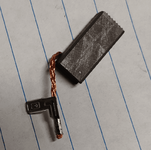- Messages
- 6,824
- Reactions
- 17,613
- Thread Starter
- #61
@awshoot Can you share those STLs and/or design files?
Yes -- when they are complete -- it will actually be a DXF file because this is just a 2.5D project -- I haven't done any 3D modeling. I have this bad habit of making my tolerances too tight and so I usually have to cut, test, recut a bunch. Still to do are the pushers for primer compound and anvils as well as the anvil grate. In other words, it isn't done yet.
I've decided with the pushers though, to make them single-nub -- I'd rather accidentally set off one primer than eight. Or at least that's my thinking.
This could also be done by hand with a drill press, a wide range of bits and some sort of cutting tool like a scroll saw or band saw. I'll share my hole dimensions too -- that's the only part that's actually important.
EDIT: the pushers could be made with aluminum rod, a power drill, and sand paper.














